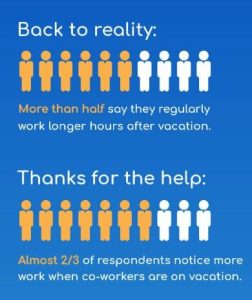Feeling burned out at work is an all-too-common condition in the workplace today. Employees spend up to 2.6 hours a day checking their email, more than eight hours a day at work and 23 hours a week stuck in meetings. Though workplace burnout is not technically a medical condition, it may lead to depression, anxiety, high blood pressure and insomnia. In fact, the World Health Organization recently classified workplace burnout as an occupational phenomenon and, consequently, a work hazard. So where can workers turn for relief? A vacation, of course. But how workers take time off can play a critical role in their well-being during and after their break.
Cornerstone surveyed 1,000 employees in the American workforce about work-life balance and the effect a long vacation can have on achieving this crucial equilibrium. The survey found 87% of workers believe that three-day weekends are actually better for stress relief than longer vacations. With a three-day weekend, workers can relax without worrying about what awaits them when they return. In fact, workers who take long vacations not only reported working longer hours upon returning to work, but they also became more stressed than they were before their break. About two-thirds of respondents also noticed more work for co-workers that were forced to pick up the slack. 
And yet, many employees are still taking sabbaticals and long vacations for some much-needed self-care. Based on its survey findings, Cornerstone has pulled together some tips for workers who do opt for longer vacations. From resetting deadlines ahead of time to organizing schedules and inboxes, here’s how to successfully return from some time away.
Prepare so you can tune out
When on a long vacation, most employees try to completely unplug from work. About 60% of survey respondents said they rarely check in with colleagues while they’re out, and 41% said they never do. However, if an employee does plan on going completely off the grid for the duration of a trip, there are steps that they and their manager should take before departure.
Managers need to plan ahead for heavy vacation periods, like these summer months or the upcoming winter holiday season. By resetting deadlines and reevaluating workflows during these times, companies can avoid falling behind when they’re understaffed. What’s more, employers can also use popular vacation times to train and develop the skills of other, newer employees.
Employees must prepare, too. If an employee leads a team, they should be sure to schedule time to set expectations for how work will be distributed while they are away. To stay organized and efficient, employees can organize their inboxes into folders so that important emails are flagged, while secondary materials like newsletters and company-wide emails are stored for a later date.
Get organized after a break
Upon return, it’s easy to become quickly overwhelmed by the amount of work that has piled up. But there are a few simple ways employees can mitigate this stress. For instance, employees can replace long, individual email catch-up sessions with check-in meetings. By catching up in-person, employees can streamline conversations and focus on what is most important and top-of-mind. With their manager’s approval, employees can also consider reorganizing their schedule to avoid any non-essential calls or meetings. This way, employees are spending their first day or two back syncing with their teams and ongoing projects.
More than anything, employees should try to relax and mindfully prioritize their schedule. A realistic timeline that places timely matters first and saves less urgent items for later can help employees successfully ease back into their work.
Reconsider the long vacation
Most jobs are stressful, but checking out of work for a full week or two while vacationing can be even more stressful. And our survey results reflect this: A three-day weekend may help reduce stress levels at work far more effectively than a long vacation. Taking a Friday or Monday off to extend the weekend every once in a while has become an increasingly popular, and possibly even better, way to reduce burnout.
“Burnout has a significant effect on the workplace,” says Kim Cassady, Cornerstone’s Chief Talent Officer. “The findings of this survey should empower organizations and employees to discuss the habits and resources that can combat it.”
In our ever-connected digital workplaces, it’s harder than ever to separate work from the rest of our lives. Vacation days should be used to maintain a healthy work-life balance, but time away is most effective when strategically and thoughtfully planned.
This article originally appeared on ReWork, a publication exploring the future of work.
